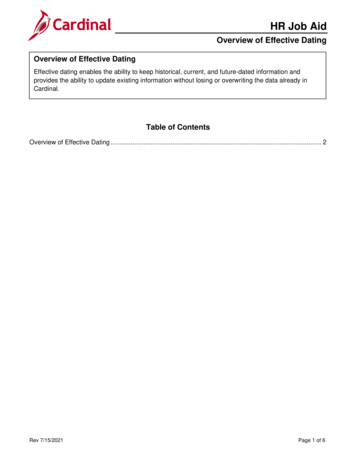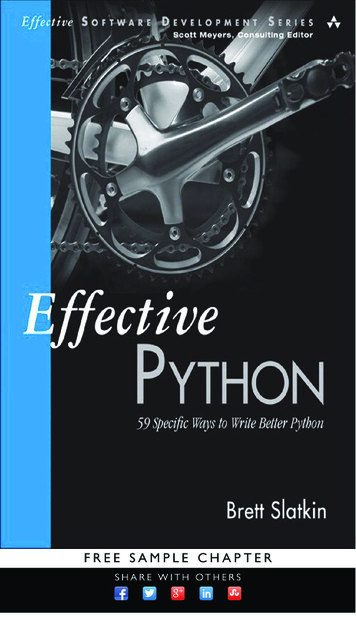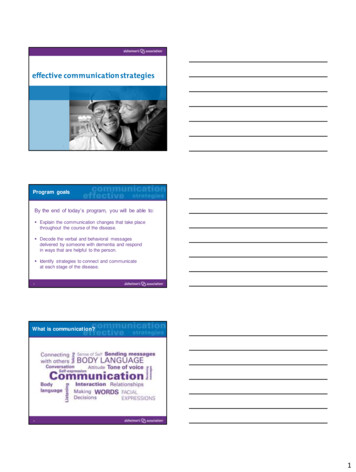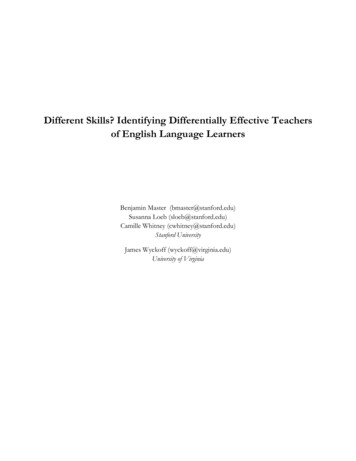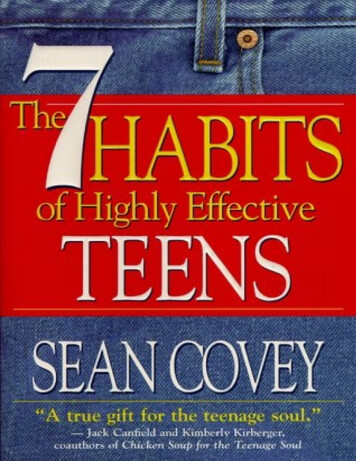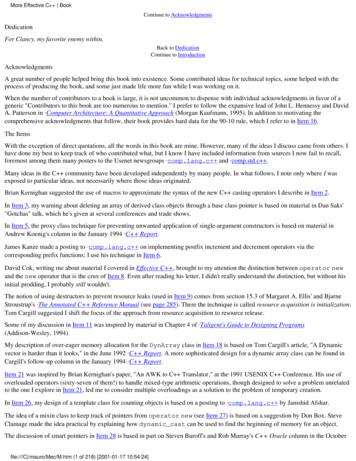
Transcription
More Effective C BookContinue to AcknowledgmentsDedicationFor Clancy, my favorite enemy within.Back to DedicationContinue to IntroductionAcknowledgmentsA great number of people helped bring this book into existence. Some contributed ideas for technical topics, some helped with theprocess of producing the book, and some just made life more fun while I was working on it.When the number of contributors to a book is large, it is not uncommon to dispense with individual acknowledgments in favor of ageneric "Contributors to this book are too numerous to mention." I prefer to follow the expansive lead of John L. Hennessy and DavidA. Patterson in Computer Architecture: A Quantitative Approach (Morgan Kaufmann, 1995). In addition to motivating thecomprehensive acknowledgments that follow, their book provides hard data for the 90-10 rule, which I refer to in Item 16.The ItemsWith the exception of direct quotations, all the words in this book are mine. However, many of the ideas I discuss came from others. Ihave done my best to keep track of who contributed what, but I know I have included information from sources I now fail to recall,foremost among them many posters to the Usenet newsgroups comp.lang.c and comp.std.c .Many ideas in the C community have been developed independently by many people. In what follows, I note only where I wasexposed to particular ideas, not necessarily where those ideas originated.Brian Kernighan suggested the use of macros to approximate the syntax of the new C casting operators I describe in Item 2.In Item 3, my warning about deleting an array of derived class objects through a base class pointer is based on material in Dan Saks'"Gotchas" talk, which he's given at several conferences and trade shows.In Item 5, the proxy class technique for preventing unwanted application of single-argument constructors is based on material inAndrew Koenig's column in the January 1994 C Report.James Kanze made a posting to comp.lang.c on implementing postfix increment and decrement operators via thecorresponding prefix functions; I use his technique in Item 6.David Cok, writing me about material I covered in Effective C , brought to my attention the distinction between operator newand the new operator that is the crux of Item 8. Even after reading his letter, I didn't really understand the distinction, but without hisinitial prodding, I probably still wouldn't.The notion of using destructors to prevent resource leaks (used in Item 9) comes from section 15.3 of Margaret A. Ellis' and BjarneStroustrup's The Annotated C Reference Manual (see page 285). There the technique is called resource acquisition is initialization.Tom Cargill suggested I shift the focus of the approach from resource acquisition to resource release.Some of my discussion in Item 11 was inspired by material in Chapter 4 of Taligent's Guide to Designing Programs(Addison-Wesley, 1994).My description of over-eager memory allocation for the DynArray class in Item 18 is based on Tom Cargill's article, "A Dynamicvector is harder than it looks," in the June 1992 C Report. A more sophisticated design for a dynamic array class can be found inCargill's follow-up column in the January 1994 C Report.Item 21 was inspired by Brian Kernighan's paper, "An AWK to C Translator," at the 1991 USENIX C Conference. His use ofoverloaded operators (sixty-seven of them!) to handle mixed-type arithmetic operations, though designed to solve a problem unrelatedto the one I explore in Item 21, led me to consider multiple overloadings as a solution to the problem of temporary creation.In Item 26, my design of a template class for counting objects is based on a posting to comp.lang.c by Jamshid Afshar.The idea of a mixin class to keep track of pointers from operator new (see Item 27) is based on a suggestion by Don Box. SteveClamage made the idea practical by explaining how dynamic cast can be used to find the beginning of memory for an object.The discussion of smart pointers in Item 28 is based in part on Steven Buroff's and Rob Murray's C Oracle column in the Octoberfile:///C /mauro/Mec/M.htm (1 of 218) [2001-01-17 10:54:24]
More Effective C Book1993 C Report; on Daniel R. Edelson's classic paper, "Smart Pointers: They're Smart, but They're Not Pointers," in theproceedings of the 1992 USENIX C Conference; on section 15.9.1 of Bjarne Stroustrup's The Design and Evolution of C (seepage 285); on Gregory Colvin's "C Memory Management" class notes from C/C Solutions '95; and on Cay Horstmann's columnin the March-April 1993 issue of the C Report. I developed some of the material myself, though. Really.In Item 29, the use of a base class to store reference counts and of smart pointers to manipulate those counts is based on Rob Murray'sdiscussions of the same topics in sections 6.3.2 and 7.4.2, respectively, of his C Strategies and Tactics (see page 286). The designfor adding reference counting to existing classes follows that presented by Cay Horstmann in his March-April 1993 column in the C Report.In Item 30, my discussion of lvalue contexts is based on comments in Dan Saks' column in the C User's Journal C/C Users Journal)of January 1993. The observation that non-proxy member functions are unavailable when called through proxies comes from anunpublished paper by Cay Horstmann.The use of runtime type information to build vtbl-like arrays of function pointers (in Item 31) is based on ideas put forward by BjarneStroustrup in postings to comp.lang.c and in section 13.8.1 of his The Design and Evolution of C (see page 285).The material in Item 33 is based on several of my C Report columns in 1994 and 1995. Those columns, in turn, included commentsI received from Klaus Kreft about how to use dynamic cast to implement a virtual operator that detects arguments of thewrong type.Much of the material in Item 34 was motivated by Steve Clamage's article, "Linking C with other languages," in the May 1992 C Report. In that same Item, my treatment of the problems caused by functions like strdup was motivated by an anonymousreviewer.The BookReviewing draft copies of a book is hard — and vitally important — work. I am grateful that so many people were willing to investtheir time and energy on my behalf. I am especially grateful to Jill Huchital, Tim Johnson, Brian Kernighan, Eric Nagler, and ChrisVan Wyk, as they read the book (or large portions of it) more than once. In addition to these gluttons for punishment, complete draftsof the manuscript were read by Katrina Avery, Don Box, Steve Burkett, Tom Cargill, Tony Davis, Carolyn Duby, Bruce Eckel, ReadFleming, Cay Horstmann, James Kanze, Russ Paielli, Steve Rosenthal, Robin Rowe, Dan Saks, Chris Sells, Webb Stacy, Dave Swift,Steve Vinoski, and Fred Wild. Partial drafts were reviewed by Bob Beauchaine, Gerd Hoeren, Jeff Jackson, and Nancy L. Urbano.Each of these reviewers made comments that greatly improved the accuracy, utility, and presentation of the material you find here.Once the book came out, I received corrections and suggestions from many people. I've listed these sharp-eyed readers in the order inwhich I received their missives: Luis Kida, John Potter, Tim Uttormark, Mike Fulkerson, Dan Saks, Wolfgang Glunz, Clovis Tondo,Michael Loftus, Liz Hanks, Wil Evers, Stefan Kuhlins, Jim McCracken, Alan Duchan, John Jacobsma, Ramesh Nagabushnam, EdWillink, Kirk Swenson, Jack Reeves, Doug Schmidt, Tim Buchowski, Paul Chisholm, Andrew Klein, Eric Nagler, Jeffrey Smith, SamBent, Oleg Shteynbuk, Anton Doblmaier, Ulf Michaelis, Sekhar Muddana, Michael Baker, Yechiel Kimchi, David Papurt, IanHaggard, Robert Schwartz, David Halpin, Graham Mark, David Barrett, Damian Kanarek, Ron Coutts, Lance Whitesel, Jon Lachelt,Cheryl Ferguson, Munir Mahmood, Klaus-Georg Adams, David Goh, Chris Morley, and Rainer Baumschlager. Their suggestionsallowed me to improve More Effective C in updated printings (such as this one), and I greatly appreciate their help.During preparation of this book, I faced many questions about the emerging ISO/ANSI standard for C , and I am grateful to SteveClamage and Dan Saks for taking the time to respond to my incessant email queries.John Max Skaller and Steve Rumsby conspired to get me the HTML for the draft ANSI C standard before it was widely available.Vivian Neou pointed me to the Netscape WWW browser as a stand-alone HTML viewer under (16 bit) Microsoft Windows, and I amdeeply grateful to the folks at Netscape Communications for making their fine viewer freely available on such a pathetic excuse for anoperating system.Bryan Hobbs and Hachemi Zenad generously arranged to get me a copy of the internal engineering version of the MetaWare C compiler so I could check the code in this book using the latest features of the language. Cay Horstmann helped me get the compilerup and running in the very foreign world of DOS and DOS extenders. Borland (now Inprise) provided a beta copy of their mostadvanced compiler, and Eric Nagler and Chris Sells provided invaluable help in testing code for me on compilers to which I had noaccess.Without the staff at the Corporate and Professional Publishing Division of Addison-Wesley, there would be no book, and I amindebted to Kim Dawley, Lana Langlois, Simone Payment, Marty Rabinowitz, Pradeepa Siva, John Wait, and the rest of the staff forfile:///C /mauro/Mec/M.htm (2 of 218) [2001-01-17 10:54:24]
More Effective C Booktheir encouragement, patience, and help with the production of this work.Chris Guzikowski helped draft the back cover copy for this book, and Tim Johnson stole time from his research on low-temperaturephysics to critique later versions of that text.Tom Cargill graciously agreed to make his C Report article on exceptions available.The PeopleKathy Reed was responsible for my introduction to programming; surely she didn't deserve to have to put up with a kid like me.Donald French had faith in my ability to develop and present C teaching materials when I had no track record. He also introducedme to John Wait, my editor at Addison-Wesley, an act for which I will always be grateful. The triumvirate at Beaver Ridge — JayniBesaw, Lorri Fields, and Beth McKee — provided untold entertainment on my breaks as I worked on the book.My wife, Nancy L. Urbano, put up with me and put up with me and put up with me as I worked on the book, continued to work on thebook, and kept working on the book. How many times did she hear me say we'd do something after the book was done? Now the bookis done, and we will do those things. She amazes me. I love her.Finally, I must acknowledge our puppy, Persephone, whose existence changed our world forever. Without her, this book would havebeen finished both sooner and with less sleep deprivation, but also with substantially less comic relief.Back to AcknowledgmentsContinue to BasicsIntroductionThese are heady days for C programmers. Commercially available less than a decade, C has nevertheless emerged as thelanguage of choice for systems programming on nearly all major computing platforms. Companies and individuals with challengingprogramming problems increasingly embrace the language, and the question faced by those who do not use C is often when theywill start, not if. Standardization of C is complete, and the breadth and scope of the accompanying library — which both dwarfs andsubsumes that of C — makes it possible to write rich, complex programs without sacrificing portability or implementing commonalgorithms and data structures from scratch. C compilers continue to proliferate, the features they offer continue to expand, and thequality of the code they generate continues to improve. Tools and environments for C development grow ever more abundant,powerful, and robust. Commercial libraries all but obviate the need to write code in many application areas.As the language has matured and our experience with it has increased, our needs for information about it have changed. In 1990,people wanted to know what C was. By 1992, they wanted to know how to make it work. Now C programmers ask higher-levelquestions: How can I design my software so it will adapt to future demands? How can I improve the efficiency of my code withoutcompromising its correctness or making it harder to use? How can I implement sophisticated functionality not directly supported bythe language?In this book, I answer these questions and many others like them.This book shows how to design and implement C software that is more effective: more likely to behave correctly; more robust in theface of exceptions; more efficient; more portable; makes better use of language features; adapts to change more gracefully; worksbetter in a mixed-language environment; is easier to use correctly; is harder to use incorrectly. In short, software that's just better.The material in this book is divided into 35 Items. Each Item summarizes accumulated wisdom of the C programming communityon a particular topic. Most Items take the form of guidelines, and the explanation accompanying each guideline describes why theguideline exists, what happens if you fail to follow it, and under what conditions it may make sense to violate the guideline anyway.Items fall into several categories. Some concern particular language features, especially newer features with which you may have littleexperience. For example, Items 9 through 15 are devoted to exceptions (as are the magazine articles by Tom Cargill, Jack Reeves, andHerb Sutter). Other Items explain how to combine the features of the language to achieve higher-level goals. Items 25 through 31, forinstance, describe how to constrain the number or placement of objects, how to create functions that act "virtual" on the type of morethan one object, how to create "smart pointers," and more. Still other Items address broader topics; Items 16 through 24 focus onefficiency. No matter what the topic of a particular Item, each takes a no-nonsense approach to the subject. In More Effective C ,you learn how to use C more effectively. The descriptions of language features that make up the bulk of most C texts are in thisbook mere background information.An implication of this approach is that you should be familiar with C before reading this book. I take for granted that youunderstand classes, protection levels, virtual and nonvirtual functions, etc., and I assume you are acquainted with the concepts behindtemplates and exceptions. At the same time, I don't expect you to be a language expert, so when poking into lesser-known corners offile:///C /mauro/Mec/M.htm (3 of 218) [2001-01-17 10:54:24]
More Effective C BookC , I always explain what's going on.The C in More Effective C The C I describe in this book is the language specified by the Final Draft International Standard of the ISO/ANSI standardizationcommittee in November 1997. In all likelihood, this means I use a few features your compilers don't yet support. Don't worry. Theonly "new" feature I assume you have is templates, and templates are now almost universally available. I use exceptions, too, but thatuse is largely confined to Items 9 through 15, which are specifically devoted to exceptions. If you don't have access to a compileroffering exceptions, that's okay. It won't affect your ability to take advantage of the material in the other parts of the book.Furthermore, you should read Items 9 through 15 even if you don't have support for exceptions, because those items (as well as theassociated articles) examine issues you need to understand in any case.I recognize that just because the standardization committee blesses a feature or endorses a practice, there's no guarantee that thefeature is present in current compilers or the practice is applicable to existing environments. When faced with a discrepancy betweentheory (what the committee says) and practice (what actually works), I discuss both, though my bias is toward things that work.Because I discuss both, this book will aid you as your compilers approach conformance with the standard. It will show you how to useexisting constructs to approximate language features your compilers don't yet support, and it will guide you when you decide totransform workarounds into newly- supported features.Notice that I refer to your compilers — plural. Different compilers implement varying approximations to the standard, so I encourageyou to develop your code under at least two compilers. Doing so will help you avoid inadvertent dependence on one vendor'sproprietary language extension or its misinterpretation of the standard. It will also help keep you away from the bleeding edge ofcompiler technology, e.g., from new features supported by only one vendor. Such features are often poorly implemented (buggy orslow — frequently both), and upon their introduction, the C community lacks experience to advise you in their proper use. Blazingtrails can be exciting, but when your goal is producing reliable code, it's often best to let others test the waters before jumping in.There are two constructs you'll see in this book that may not be familiar to you. Both are relatively recent language extensions. Somecompilers support them, but if your compilers don't, you can easily approximate them with features you do have.The first construct is the bool type, which has as its values the keywords true and false. If your compilers haven't implementedbool, there are two ways to approximate it. One is to use a global enum:enum bool { false, true };This allows you to overload functions on the basis of whether they take a bool or an int, but it has the disadvantage that the built-incomparison operators (i.e., , , , etc.) still return ints. As a result, code like the following will not behave the way it's supposedto:void f(int);void f(bool);int x, y;.f( x y );// calls f(int), but it// should call f(bool)The enum approximation may thus lead to code whose behavior changes when you submit it to a compiler that truly supports bool.An alternative is to use a typedef for bool and constant objects for true and false:typedef int bool;const bool false 0;const bool true 1;This is compatible with the traditional semantics of C and C , and the behavior of programs using this approximation won't changewhen they're ported to bool-supporting compilers. The drawback is that you can't differentiate between bool and int whenoverloading functions. Both approximations are reasonable. Choose the one that best fits your circumstances.The second new construct is really four constructs, the casting forms static cast, const cast, dynamic cast, andreinterpret cast. If you're not familiar with these casts, you'll want to turn to Item 2 and read all about them. Not only do theydo more than the C-style casts they replace, they do it better. I use these new casting forms whenever I need to perform a cast in thisbook.There is more to C than the language itself. There is also the standard library (see Item E49). Where possible, I employ the standardstring type instead of using raw char* pointers, and I encourage you to do the same. string objects are no more difficult tofile:///C /mauro/Mec/M.htm (4 of 218) [2001-01-17 10:54:24]
More Effective C Bookmanipulate than char*-based strings, and they relieve you of most memory-management concerns. Furthermore, string objectsare less susceptible to memory leaks if an exception is thrown (see Items 9 and 10). A well-implemented string type can hold itsown in an efficiency contest with its char* equivalent, and it may even do better. (For insight into how this could be, see Item 29.) Ifyou don't have access to an implementation of the standard string type, you almost certainly have access to some string-likeclass. Use it. Just about anything is preferable to raw char*s.I use data structures from the standard library whenever I can. Such data structures are drawn from the Standard Template Library (the"STL" — see Item 35). The STL includes bitsets, vectors, lists, queues, stacks, maps, sets, and more, and you should prefer thesestandardized data structures to the ad hoc equivalents you might otherwise be tempted to write. Your compilers may not have the STLbundled in, but don't let that keep you from using it. Thanks to Silicon Graphics, you can download a free copy that works with manycompilers from the SGI STL web site.If you currently use a library of algorithms and data structures and are happy with it, there's no need to switch to the STL just becauseit's "standard." However, if you have a choice between using an STL component or writing your own code from scratch, you shouldlean toward using the STL. Remember code reuse? STL (and the rest of the standard library) has lots of code that is very much worthreusing.Conventions and TerminologyAny time I mention inheritance in this book, I mean public inheritance (see Item E35). If I don't mean public inheritance, I'll say soexplicitly. When drawing inheritance hierarchies, I depict base-derived relationships by drawing arrows from derived classes to baseclasses. For example, here is a hierarchy from Item 31:file:///C /mauro/Mec/M.htm (5 of 218) [2001-01-17 10:54:24]
More Effective C BookThis notation is the reverse of the convention I employed in the first (but not the second) edition of Effective C . I'm now convincedthat most C practitioners draw inheritance arrows from derived to base classes, and I am happy to follow suit. Within suchdiagrams, abstract classes (e.g., GameObject) are shaded and concrete classes (e.g., SpaceShip) are unshaded.Inheritance gives rise to pointers and references with two different types, a static type and a dynamic type. The static type of a pointeror reference is its declared type. The dynamic type is determined by the type of object it actually refers to. Here are some examplesbased on the classes above:GameObject *pgo // static type of pgo isnew SpaceShip;// GameObject*, dynamic// type is SpaceShip*Asteroid *pa new Asteroid;// static type of pa is// Asteroid*. So is its// dynamic typepgo pa;// static type of pgo is// still (and always)// GameObject*. Its// dynamic type is now// Asteroid*GameObject& rgo *pa;// static type of rgo is// GameObject, dynamic// type is AsteroidThese examples also demonstrate a naming convention I like. pgo is a pointer-to-GameObject; pa is a pointer-to-Asteroid; rgois a reference-to-GameObject. I often concoct pointer and reference names in this fashion.Two of my favorite parameter names are lhs and rhs, abbreviations for "left-hand side" and "right-hand side," respectively. Tounderstand the rationale behind these names, consider a class for representing rational numbers:class Rational { . };If I wanted a function to compare pairs of Rational objects, I'd declare it like this:bool operator (const Rational& lhs, const Rational& rhs);That would let me write this kind of code:Rational r1, r2;.if (r1 r2) .Within the call to operator , r1 appears on the left-hand side of the " " and is bound to lhs, while r2 appears on thefile:///C /mauro/Mec/M.htm (6 of 218) [2001-01-17 10:54:24]
More Effective C Bookright-hand side of the " " and is bound to rhs.Other abbreviations I employ include ctor for "constructor," dtor for "destructor," and RTTI for C 's support for runtime typeidentification (of which dynamic cast is the most commonly used component).When you allocate memory and fail to free it, you have a memory leak. Memory leaks arise in both C and C , but in C , memoryleaks leak more than just memory. That's because C automatically calls constructors when objects are created, and constructors maythemselves allocate resources. For example, consider this code:class Widget { . };// some class — it doesn't// matter what it isWidget *pw new Widget;// dynamically allocate a// Widget object.// assume pw is never// deletedThis code leaks memory, because the Widget pointed to by pw is never deleted. However, if the Widget constructor allocatesadditional resources that are to be released when the Widget is destroyed (such as file descriptors, semaphores, window handles,database locks, etc.), those resources are lost just as surely as the memory is. To emphasize that memory leaks in C often leak otherresources, too, I usually speak of resource leaks in this book rather than memory leaks.You won't see many inline functions in this book. That's not because I dislike inlining. Far from it, I believe that inline functions are animportant feature of C . However, the criteria for determining whether a function should be inlined can be complex, subtle, andplatform-dependent (see Item E33). As a result, I avoid inlining unless there is a point about inlining I wish to make. When you see anon-inline function in More Effective C , that doesn't mean I think it would be a bad idea to declare the function inline, it justmeans the decision to inline that function is independent of the material I'm examining at that point in the book.A few C features have been deprecated by the standardization committee. Such features are slated for eventual removal from thelanguage, because newer features have been added that do what the deprecated features do, but do it better. In this book, I identifydeprecated constructs and explain what features replace them. You should try to avoid deprecated features where you can, but there'sno reason to be overly concerned about their use. In the interest of preserving backward compatibility for their customers, compilervendors are likely to support deprecated features for many years.A client is somebody (a programmer) or something (a class or function, typically) that uses the code you write. For example, if youwrite a Date class (for representing birthdays, deadlines, when the Second Coming occurs, etc.), anybody using that class is yourclient. Furthermore, any sections of code that use the Date class are your clients as well. Clients are important. In fact, clients are thename of the game! If nobody uses the software you write, why write it? You will find I worry a lot about making things easier forclients, often at the expense of making things more difficult for you, because good software is "clientcentric" — it revolves aroundclients. If this strikes you as unreasonably philanthropic, view it instead through a lens of self-interest. Do you ever use the classes orfunctions you write? If so, you're your own client, so making things easier for clients in general also makes them easier for you.When discussing class or function templates and the classes or functions generated from them, I reserve the right to be sloppy aboutthe difference between the templates and their instantiations. For example, if Array is a class template taking a type parameter T, Imay refer to a particular instantiation of the template as an Array, even though Array T is really the name of the class. Similarly,if swap is a function template taking a type parameter T, I may refer to an instantiation as swap instead of swap T . In cases wherethis kind of shorthand might be unclear, I include template parameters when referring to template instantiations.Reporting Bugs, Making Suggestions, Getting Book UpdatesI have tried to make this book as accurate, readable, and useful as possible, but I know there is room for improvement. If you find anerror of any kind — technical, grammatical, typographical, whatever — please tell me about it. I will try to correct the mistake infuture printings of the book, and if you are the first person to report it, I will gladly add your name to the book's acknowledgments. Ifyou have other suggestions for improvement, I welcome those, too.I continue to collect guidelines for effective programming in C . If you have ideas for new guidelines, I'd be delighted if you'd sharethem with me. Send your guidelines, your comments, your criticisms, and your bug reports to:Scott Meyersc/o Editor-in-Chief, Corporate and Professional PublishingAddison-Wesley Publishing Company1 Jacob WayReading, MA 01867file:///C /mauro/Mec/M.htm (7 of 218) [2001-01-17 10:54:24]
More Effective C BookU. S. A.Alternatively, you may send electronic mail to mec @awl.com.I maintain a list of changes to this book since its first printing, including bug-fixes, clarifications, and technical updates. This list,along with other book-related information, is available from the Web site for this book. It is also available via anonymous FTP from ftp.awl.com in the directory cp/mec . If you would like a copy of the list of changes to this book, but you lack access to theInternet, please send a request to one of the addresses above, and I will see that the list is sent to you.Enough preliminaries. On with the show!Back to IntroductionContinue to Item 1: Distinguish between pointers and referencesBasicsAh, the basics. Pointers, references, casts, arrays, constructors — you can't get much more basic than that. All but the simplest C programs use most of these features, and many programs use them all.In spite of our familiarity with these parts of the language, sometimes they can still surprise us. This is especially true for programmersmaking the transition from C to C , because the concepts behind references, dynamic casts, default constructors, and other non-Cfeatures are usually a little murky.This chapter describes the differences between pointers and references and offers guidance on when to use each. It introduces the newC syntax for casts and explains why the new casts are superior to the C-style casts they replace. It examines the C notion of arraysand the C notion of polymorphism, and it describes why mixing the two is an idea whose time will never come. Finally, it considersthe pros and cons of default constructors and suggests ways to work around language restrictions that encourage you to have one whennone m
1993 C Report; on Daniel R. Edelson's classic paper, "Smart Pointers: They're Smart, but They're Not Pointers," in the proceedings of the 1992 USENIX C Conference; on section 15.9.1 of Bjarne Stroustrup's The Design and Evolution of C (see page 285); on Gregory Colvin's "C Memory Management" class notes from C/C Solutions '95; and on Cay Horstmann's column

